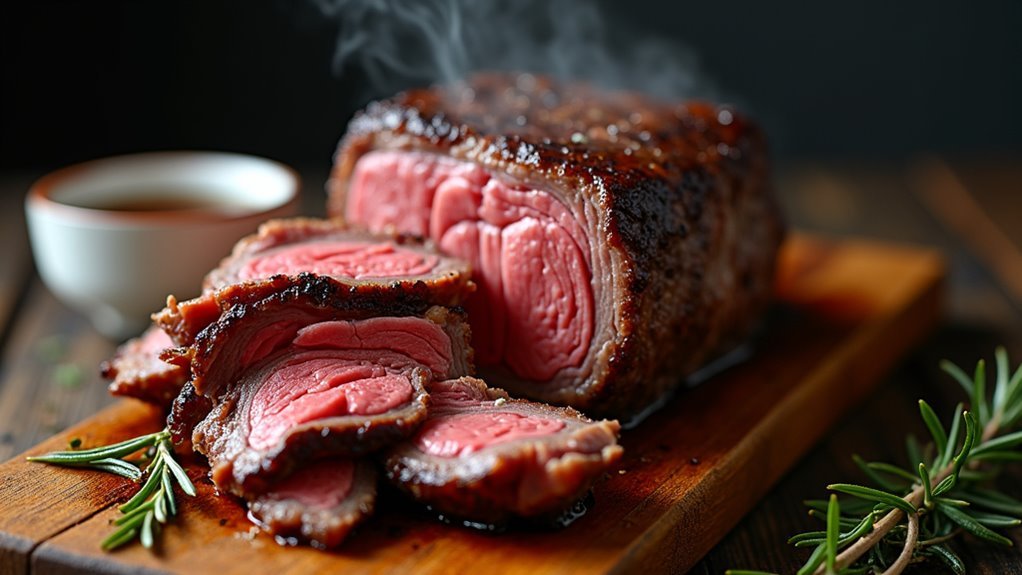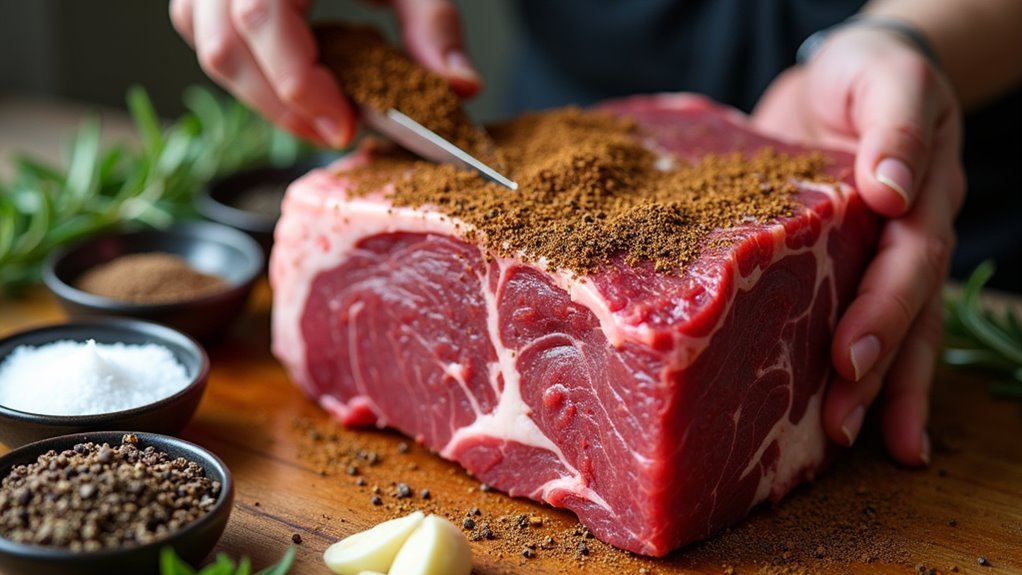Sous vide transforms tough beef cuts into melt-in-your-mouth shredded goodness with minimal effort. You’ll need to cook at 175°F for 24 hours to perfectly break down collagen fibers while locking in moisture and flavor. Chuck roast works best, seasoned generously before vacuum sealing. After cooking, a quick sear adds delightful texture before shredding with two forks. Perfect for tacos, sandwiches, or nachos – the possibilities might just surprise you.
Why Sous Vide Is Perfect for Shredded Beef

When it comes to transforming tough cuts of beef into melt-in-your-mouth shredded meat, sous vide cooking stands in a league of its own.
The magic happens at precisely 175°F maintained for a full 24 hours, breaking down those stubborn collagen fibers that make certain cuts tough.
The perfect alchemy of time and temperature transforms even the most stubborn cuts into fork-tender perfection.
You’ll notice the difference immediately – consistent tenderness throughout the entire roast, not just in certain spots.
I think what really sets sous vide apart is how it locks in moisture. Unlike traditional methods where juices often escape, your beef retains all its natural flavors, perhaps creating the juiciest shredded beef you’ve ever tasted. Additionally, vacuum sealing your beef prior to sous vide cooking enhances flavor retention while also extending food freshness, allowing you to enjoy longer-lasting sealed foods with maximum taste and nutritional value.
Equipment You’ll Need for Success
To achieve the tender, juicy shredded beef we’ve been discussing, you’ll need a few key pieces of equipment – I always say the right tools make all the difference.
First, invest in a reliable sous vide machine like the Anova Precision Cooker or Breville Joule for precise temperature control.
You’ll also need a 12-quart container with a lid to prevent evaporation during those long 24-hour cooks.
Don’t forget proper sealing methods – either vacuum sealer bags or ziplock bags for the water displacement technique. I think the vacuum sealer gives better results, personally. Additionally, using a reliable vacuum sealer can ensure a perfect seal, enhancing the cooking process through adjustable vacuum levels that will prevent any leakage during sous vide cooking.
Finally, prepare something for searing afterward – a cast iron pan works perfectly!
The Ideal Time and Temperature Settings
For ideal results with sous vide shredded beef, I’ve found that 175°F for 24 hours produces that melt-in-your-mouth texture everyone raves about.
It’s this extended cooking time that really breaks down all the collagen in tougher cuts like chuck roast.
You’ll notice the meat becomes incredibly tender yet still juicy—quite different from traditional methods that often dry out the beef.
If you’re short on time, I think you could potentially reduce to 20 hours, but I wouldn’t go much lower.
Remember to factor in the size of your roast too. Larger cuts might need those full 24 hours to reach perfection. Additionally, using vacuum sealing for marinating can enhance flavor infusion, ensuring every bite is bursting with deliciousness.
Preparing Your Roast for Maximum Flavor

Before diving into the prep work, selecting the right cut of beef is absolutely crucial for your sous vide shredded beef success. Chuck roast is typically your best bet, though eye of round can work too if you prefer a different texture.
I think applying a dry rub while the meat’s still frozen helps the flavors penetrate deeply. Pat your roast dry, then generously season it with your favorite spices.
Perhaps add a touch of olive oil to help everything adhere better. Additionally, remember to consider nutrient preservation when vacuum sealing your beef, as this will enhance the overall quality and flavor during the cooking process.
Remember to package your beef properly – either vacuum seal it or use the water displacement method to remove air. This prevents floating and guarantees even cooking.
Perfecting the Sear After Sous Vide
After your beef has bathed in its sous vide spa for those long hours, the searing step becomes your make-or-break moment. The perfect sear adds that beautiful crust and deep flavor that elevates your shredded beef from good to extraordinary.
First, pat your meat completely dry—I can’t stress this enough. Moisture is the enemy of a good sear. Then heat your cast iron until it’s smoking hot before adding your roast. It’s essential to remember that precise temperature control is vital for even cooking in sous vide.
| Searing Method | Time Per Side | Best For |
|---|---|---|
| Cast Iron Pan | 1-2 minutes | Even crust |
| Grill | 1 minute | Char flavor |
| Torch | Variable | Tight spots |
| Broiler | 2-3 minutes | Hands-off |
| Smoker | 30 minutes | Added smoke |
Shredding Techniques and Serving Suggestions
Once you’ve achieved that perfect sear on your sous vide beef, it’s time to transform it into succulent, pull-apart shreds that’ll make your guests swoon.
Let the meat rest for about 5 minutes first—this helps retain those precious juices.
For shredding, I think two forks work perfectly. Simply pull them in opposite directions through the tender beef, which should separate effortlessly after that 24-hour bath at 175°F.
Perhaps try using your fingers for larger pieces if the meat isn’t too hot.
Serve your shredded masterpiece on brioche buns for sandwiches, stuff into tacos, or layer over nachos.
Additionally, consider vacuum sealing any leftovers to enhance the longevity of your delicious creation, ensuring it stays fresh much longer than traditional storage methods.
The possibilities are endless!
Frequently Asked Questions
Can I Reuse the Sous Vide Cooking Liquid for Other Recipes?
You can reuse sous vide cooking liquid for stocks, sauces, or gravy bases. Strain it first to remove impurities and store properly. It’ll add rich flavor to your dishes.
How Do I Prevent the Bag From Floating During Cooking?
To prevent floating bags, use a vacuum sealer or water displacement method, secure with bag clips, add weights like heavy spoons, or use sous vide magnets/weights on opposite sides.
Is It Safe to Leave the Sous Vide Running Overnight Unattended?
You’re stepping into risky territory. While sous vide machines are designed for long cooks, leaving them completely unattended overnight creates fire and water damage risks. Use a timer if possible.
Can I Cook Frozen Beef Directly Without Thawing First?
Yes, you can cook frozen beef directly in your sous vide. You’ll need to add about 50% more cooking time to guarantee it’s properly cooked through and tender.
Will Sous Vide Cooking Tenderize Cheaper, Tougher Cuts of Beef Effectively?
You’ve found the secret! Sous vide transforms tough cuts into tender gold. The long, low-temperature cooking breaks down collagen in cheaper cuts, making them incredibly succulent and flavorful for you.
